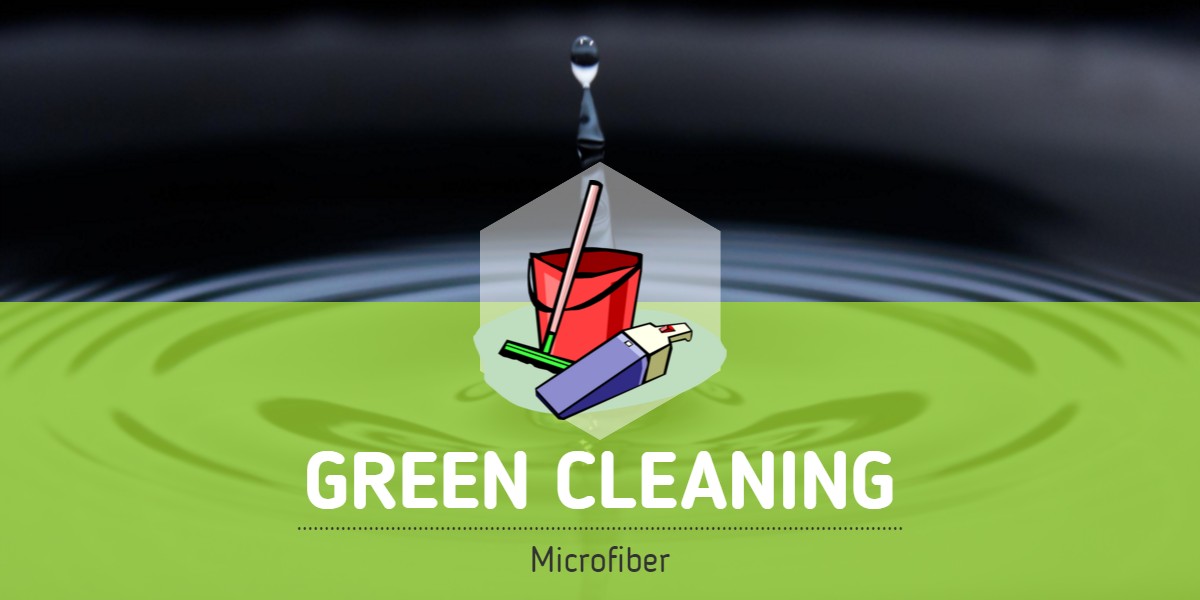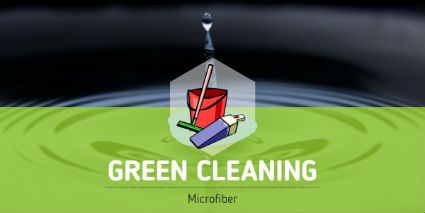Microfiber is one of the essential tools used in green cleaning.

Green Cleaning Services and Microfiber
Traditional cleaning services rely on cotton-based cloth and fibers to absorb water and chemical cleaning solutions.
The water and cleaner combine to break up dirt, oil, and grease in a process called emulsification.
What Is Emulsification?
[sic]...is an agent that causes fats and oils that wouldn’t otherwise dissolve in a cleaning solution to break down into small enough particles that they become suspended in the solution.
The suspended particles are then soaked up by a cloth or mop.
This presents two fundamental health issues:
- Traditional absorption/cleaning materials are less efficient than microfiber at absorbing water, cleaning solution, dirt, and oil. Since cotton based cleaning fibers are less capable of absorption than microfiber, they tend to leave dirty, germ-ridden water on the ground, as well as a film of chemical solvent; both of which can present serious health hazards to sensitive groups.
- Due to their larger fiber strands, traditional cleaning materials must rely on antibacterial products to remove germs and bacteria. The overuse of antibacterial cleaning products has been shown to increase the progression of antibiotic-resistant bacteria strains.
What Is Microfiber?
[sic]...is synthetic fiber finer than one denier or decitex/thread.
This is smaller than the diameter of a strand of silk (which is approximately one denier), which is itself about 1/5 the diameter of a human hair.
The most common types of microfibers are made from polyesters, polyamides (e.g., nylon, Kevlar, Nomex, trogamide), or a conjugation of polyester, polyamide, and polypropylene (Prolen).
Microfiber is used to make mats, knits, and weaves for apparel, upholstery, industrial filters, and cleaning products.
The shape, size, and combinations of synthetic fibers are selected for specific characteristics, including softness, toughness, absorption, water repellency, electrostatics, and filtering capabilities.
How Does Microfiber Work?
Microfiber threads are split 16 times to a width of up to '100 times finer than a human hair.'
This process provides two advantages over traditional cleaning cloths of comparable size:
- Increases the surface area of the fabric.
- Creates 'pockets' that trap dirt, as opposed to pushing it around, as is the case with traditional cleaning materials.
As noted above, where traditional cleaning methods rely heavily on antibacterial solvents, the pockets in microfiber cloth cause common, disease-causing bacteria to be trapped with the use of less-harsh, natural solutions, and cold water.
For More Information:
Additional Benefits
The use of microfiber provides several benefits to businesses, specifically where the company outsources to a 3rd party office cleaning service.
- Ergonomic Design
- Cross Contamination
- Cost
Ergonomic Design
A green approach has always come with the connotation of 'health first'.
Green cleaning services are designed with the physical health and wellbeing of the person using the tools, as well as the surface they are cleaning.
Handles and pad frames in the best microfiber cleaning systems are made from lightweight aluminum and are ergonomically designed to reduce the physical stresses of cleaning.
A microfiber mop, used slightly damp, is many times lighter than a conventional wet cotton mop.
Ergonomic features include: a uniquely shaped grip and angle of handle which eliminates the stress of cleaning with a “figure 8” motion, convertible handles that switch to a “vacuum cleaner style” push-pull grip for comfortably cleaning large areas, and a telescoping feature that allows workers to adjust the handle to the best height for them.
A May 2011 study conducted by the University of California concluded:
This project has confirmed that the custodial/housekeeper/environmental service workers are exposed to a variety of ergonomic risk factors and have a high risk of injury. In order to reduce injuries, both physical and psychosocial risk factors must be considered when developing system-wide strategies. These strategies should
These strategies should focus on trash/recycle and linen handling, mopping and bathroom cleaning and vacuuming and lifting/moving
furniture.
Cross-Contamination
Any cleaning service, whether in-house or outsourced, runs the risk of cross-contaminating surfaces.
Cross-contamination occurs when a rag or cloth that has been used to clean one surface is used again to clean another.
To prevent cross-contamination, microfiber cloths and mops are color-coded and can quickly be switched out when moving from one surface/room to another.
Microfiber cloths and mops are available in different colors so that a color-coding system can be implemented for specific uses.
For instance, in bathrooms, pink cloths can be used for toilets and yellow cloths for sinks.
Green cloths can be used for office cleaning.
The cost of microfiber use in business varies, and its worth depends on the value a company places on a clean, healthy office environment.
The price can be estimated as a product of the quality of material and the number and thoroughness of cleanings required.
However, as green cleaning systems do not require the use of hot water, a reduction in energy usage must also be factored in to calculate the total cost of use.
Material
Microfiber is less efficient after a set number of uses and washings.
That number is typically a product of the quality of the material.
Essentially, the higher the quality of the material, the more efficient the cloth will be, and the longer it will last.
For More Information:
Replacement
To avoid issues associated with the natural degradation in the quality of any cleaning material, it is recommended a business implement a routine replacement schedule.
A study conducted by CIRIScience.org concluded that:
Microfiber cloths showed the best results when being used in new condition. However, after multiple reprocessing, cotton cloth showed the best overall efficacy.
Microfiber Compared with Other Commonly Used Cleaning Cloths
This can, at first glance, make microfiber seem financially unappealing.
However, a long-term study conducted by the EPA, when comparing 'wet loop' mops to microfiber mops at the University of California-Davis discovered the following:
As you can see, 2 practical business-financial related conclusions can be drawn from this study:
- Microfiber use comes with a lower, total cost of ownership over a similar timeframe than wet loop mops.
- Microfiber mops used less water and chemicals, further reducing total cost of ownership, as well as health and environmental impact.
Energy
Microfiber saves on energy costs in several ways, as presented by the ISSA, a 'leading trade association for the cleaning industry.'
The first being that it does not need to be washed after each use.
Microfiber cloths and mop heads do not have to be washed after each use. For instance, if they are used for dusting, they can be shaken outside to remove dust and soils or hand-rinsed in warm water.
The second reason, complementing the first, is that it does not typically require hot water to activate active chemicals in cleaning solutions, and only in extremely dirty conditions.
“Reduce your building’s toxic footprint by using plant-based, biodegradable cleaners,” recommends Roger McFadden, vice president and senior scientist at Business Interiors by Staples. “You’ll see returns in improved IAQ, worker productivity, and reduced absenteeism.”
If you would like to learn more about the benefits of green cleaning services for your business, contact us today for a free quote!
In Bakersfield CA, call 661-395-3009
In Fresno CA, call 559-473-1790

